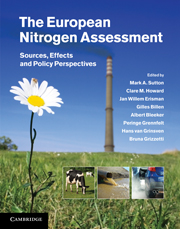Book contents
- Frontmatter
- Contents
- List of contributors
- Foreword
- Summary for policy makers
- Technical summary
- 1 Assessing our nitrogen inheritance
- Part I Nitrogen in Europe: the present position
- Part II Nitrogen processing in the biosphere
- Part III Nitrogen flows and fate at multiple spatial scales
- Part IV Managing nitrogen in relation to key societal threats
- Part V European nitrogen policies and future challenges
- 22 Costs and benefits of nitrogen in the environment
- 23 Developing integrated approaches to nitrogen management
- 24 Future scenarios of nitrogen in Europe
- 25 Coordinating European nitrogen policies between international conventions and intergovernmental organizations
- 26 Societal choice and communicating the European nitrogen challenge
- Glossary
- Index
- References
22 - Costs and benefits of nitrogen in the environment
from Part V - European nitrogen policies and future challenges
Published online by Cambridge University Press: 16 May 2011
- Frontmatter
- Contents
- List of contributors
- Foreword
- Summary for policy makers
- Technical summary
- 1 Assessing our nitrogen inheritance
- Part I Nitrogen in Europe: the present position
- Part II Nitrogen processing in the biosphere
- Part III Nitrogen flows and fate at multiple spatial scales
- Part IV Managing nitrogen in relation to key societal threats
- Part V European nitrogen policies and future challenges
- 22 Costs and benefits of nitrogen in the environment
- 23 Developing integrated approaches to nitrogen management
- 24 Future scenarios of nitrogen in Europe
- 25 Coordinating European nitrogen policies between international conventions and intergovernmental organizations
- 26 Societal choice and communicating the European nitrogen challenge
- Glossary
- Index
- References
Summary
Executive summary
Nature of the problem
Single issue policies have been an effective means of reducing reactive nitrogen (Nr) emissions in the EU, but to make further reductions more-integrated approaches are required.
Approaches
This chapter shows how cost–benefit analysis (CBA) can provide guidance for the setting of new policy priorities for the abatement of the European Nr emissions from an integrated perspective.
Data on costs and benefits of Nr-abatement, including four national and regional case studies, are reviewed and made comparable by expression in euro per kg of added Nr (agriculture) or euro per kg of reduced Nr emission (unit cost approach).
Social cost estimates are based on Willingness to Pay (WTP) for human life or health, for ecosystem services and greenhouse gas (GHG) emission reduction.
Key findings
The total annual Nr-related damage in EU27 ranges between 70 and 320 billion Euro, equivalent to 150–750 euro/capita, of which about 75% is related to health damage and air pollution. This damage cost constitutes 1%–4% of the average European income.
Inferred social costs of health impacts from NOx are highest (10–30 euro per kg of pollutant-Nr emission). Health costs from secondary ammonium particles (2–20 euro/kg N), from GHG balance effects of N2O (5–15 euro/kg N), from ecosystem impacts via N-runoff (5–20 euro/kg N) and by N-deposition (2–10 euro/kg N) are intermediate. Costs of health impacts from NO3 in drinking water (0–4 euro/kg N) and by N2O via stratospheric ozone depletion (1–3 euro/kg N) are estimated to be low.
[…]
- Type
- Chapter
- Information
- The European Nitrogen AssessmentSources, Effects and Policy Perspectives, pp. 513 - 540Publisher: Cambridge University PressPrint publication year: 2011
References
- 40
- Cited by



